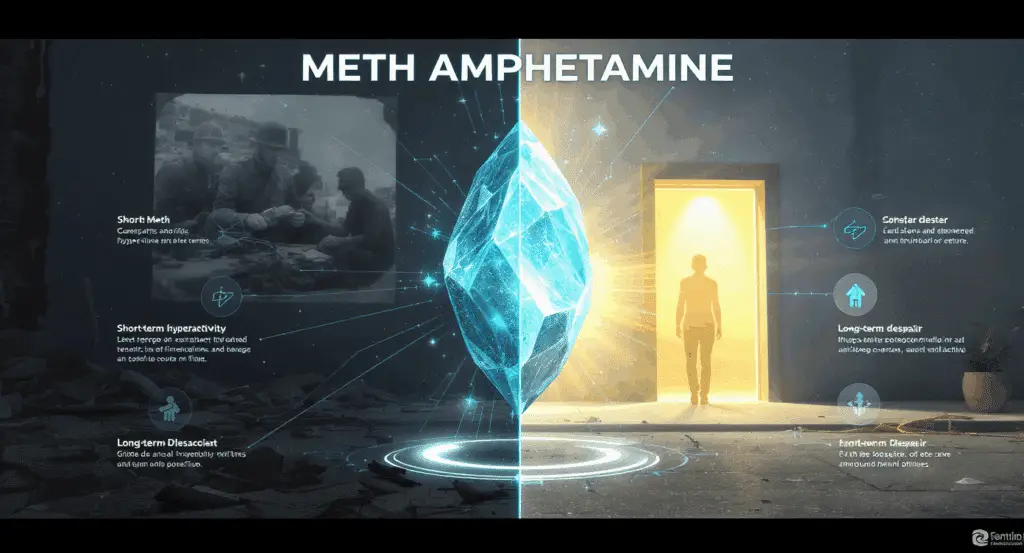CRYSTAL METH
& METAMFETAMIINI
MITÄ SINUN ON TIEDETTÄVÄ
NARCONON
Täydellinen koulutuslähde
Lataa koko Narcononin kristallimetamfetamiini- ja metamfetamiinikoulutusesite, josta saat kattavaa tietoa.
Lataa täydellinen PDF-esiteTäydellinen koulutusmateriaali Narcononilta
Mikä on Crystal Meth?
CRYSTAL METH ON LYHENNE SANOISTA CRYSTAL METHAMPHETAMINE. Se on yksi metamfetamiinin muoto, mutta se on vahvempi, kovempi, riippuvuutta aiheuttavampi ja vahingollisempi.
Metamfetamiini on valkoinen kiteinen huume, jota ihmiset käyttävät nuuskaamalla, polttamalla tai pistämällä sitä neulalla. Jotkut ottavat sitä jopa suun kautta, mutta kaikki kehittävät voimakkaan halun jatkaa käyttöä, koska huume luo vääränlaisen onnellisuuden ja hyvinvoinnin tunteen - itsevarmuuden, yliaktiivisuuden ja energian. Ihmiset kokevat myös ruokahalun vähenevän. Nämä huumeiden vaikutukset kestävät yleensä kuudesta kahdeksaan tuntia, mutta voivat kestää jopa kaksikymmentäneljä tuntia. Ensimmäiseen kokemukseen saattaa liittyä jonkinlaista mielihyvää, mutta alusta alkaen metamfetamiini alkaa tuhota käyttäjän elämää.
Mitä metamfetamiini on?
METAMFETAMIINI ON LAITON HUUME, JOKA KUULUU SAMAAN LUOKKAAN KUIN KOKAIINI JA MUUT KATUHUUMEET. Se on voimakkaasti riippuvuutta aiheuttava stimulantti, joka vaikuttaa dramaattisesti keskushermostoon.
Kaikista markkinoilla olevista laittomista huumeista metamfetamiinilla on hieman ainutlaatuinen asema. Jos metamfetamiinin valmistaja saa muutaman peruskemikaalin, hän voi perustaa liikkeen minne tahansa. Toisin kuin muut huumeet, metamfetamiinin valmistajan ei tarvitse käyttää heroiinimunkin, kokalehden tai marihuanan kaltaisia viljelykasveja, joita viljellään vain syrjäisillä tai syrjäisillä alueilla. Hän ei myöskään tarvitse yhteistyöhaluista apteekkaria laittomasti jaettuja reseptilääkkeitä varten.
Näiden tekijöiden yhdistelmä tekee metamfetamiinista huumeen, jolla on suuret mahdollisuudet laajamittaiseen käyttöön. Sillä on monia lempinimiä - met, crank, chalk tai speed ovat yleisimpiä. (Luettelo kadunnimistä on sivulla 13).
Samanlaisten piristeiden tapaan metamfetamiinia käytetään useimmiten humalahakuisesti. Koska metamfetamiinin sietokyky kehittyy muutamassa minuutissa - mikä tarkoittaa, että nautinnolliset vaikutukset häviävät jo ennen kuin huumeiden pitoisuus veressä laskee merkittävästi - käyttäjät yrittävät ylläpitää huumaa nauttimalla lääkettä.
Metamfetamiinia käyttävät kaikenikäiset, mutta sitä käytetään yleisimmin klubihuumeena, jota käytetään yökerhoissa tai rave-juhlissa. Sen yleisimmät kadunnimet ovat ice tai glass.
Se on vaarallinen ja voimakas kemikaali, ja kuten kaikki huumeet, se on myrkky, joka toimii ensin piristeenä mutta alkaa sitten järjestelmällisesti tuhota elimistöä.
Näin ollen se liittyy vakaviin terveysongelmiin, kuten muistin menetykseen, aggressiivisuuteen, psykoottiseen käyttäytymiseen sekä mahdollisiin sydän- ja aivovaurioihin.
Voimakkaasti riippuvuutta aiheuttava amfetamiini polttaa elimistön luonnolliset vitamiini- ja kivennäisainevarat ja aiheuttaa tuhoisan riippuvuuden, jota voi lievittää vain ottamalla enemmän huumetta.
Kristallimetan vaikutus on erittäin voimakas, ja monet käyttäjät kertovat jäävänsä riippuvaisiksi heti ensimmäisellä käyttökerralla. "Kokeilin sitä kerran ja BOOM! Olin koukussa", sanoi eräs metanarkomaani, joka menetti perheensä, ystävänsä ja muusikon ammattinsa ja päätyi kodittomaksi.
Näin ollen se on yksi vaikeimmin hoidettavista huumeriippuvuuksista.
Mistä metamfetamiinia valmistetaan?
METAMFETAMIINI ON SYNTEETTINEN (IHMISEN VALMISTAMA) KEMIKAALI, toisin kuin esimerkiksi kokaiini, joka on peräisin kasvista.
Metamfetamiinia valmistetaan yleisesti laittomissa, piilotetuissa laboratorioissa, joissa amfetamiinin eri muotoja sekoitetaan muihin kemikaaleihin sen tehon lisäämiseksi. Huumeen valmistuksen pohjana käytetään usein tavallisia flunssalääkkeitä. Metamfetamiinin "kokki" poimii aineet näistä pillereistä, ja vahvuuden lisäämiseksi aineet yhdistetään kemikaaleihin, kuten akkuhappoon, viemärin puhdistusaineeseen, lyhtypolttoaineeseen ja pakkasnesteeseen.
VAARALLISET KEMIKAALIT
Nämä vaaralliset kemikaalit voivat olla räjähdysalttiita, ja koska metamfetamiinin kokit ovat usein itse huumeiden käyttäjiä ja sekaisin, he saavat usein vakavia palovammoja ja vammautuvat tai jopa kuolevat, kun heidän valmisteensa räjähtävät. Tällaiset onnettomuudet vaarantavat muut läheisissä kodeissa tai rakennuksissa asuvat ihmiset.
Jokainen huumausainetta käyttävä henkilö altistuu paitsi itse kovalle stimulantille, myös sen valmistuksessa käytettyjen syövyttävien ja myrkyllisten kemikaalien jäljille ja jäämille. Näiden kemikaalien terveysvaikutukset kehoon ja mieleen ovat raa'at.
Miltä metamfetamiini näyttää?
Metamfetamiini on yleensä kiteistä valkoista jauhetta, joka on hajutonta ja karvaan makuista ja liukenee helposti veteen tai alkoholiin.
Jauheen muita värejä ovat ruskea, kellanharmaa, oranssi ja jopa vaaleanpunainen. Se voidaan myös puristaa pillerimuotoon. Kuten aiemmin käsiteltiin, sitä voidaan nuuskailla, polttaa tai ruiskuttaa.
Kristallimetamfetamiini on kirkkaita, jäätä muistuttavia kookkaita kiteitä, ja sitä poltetaan yleisimmin.
Metamfetamiinin tappavat vaikutukset
METAMFETAMIINI JA KRISTALLIMETAMFETAMIINI AIHEUTTAVAT NAUTITTUNA VÄÄRÄNLAISTA HYVINVOINNIN JA ENERGIAN TUNNETTA. joten ihminen pyrkii työntämään kehoaan nopeammin ja pidemmälle kuin sen on tarkoitus mennä. Näin ollen huumeiden käyttäjät voivat kokea vakavan romahduksen eli fyysisen ja henkisen romahduksen sen jälkeen, kun huumeiden vaikutus on ohi.
Koska lääkkeen jatkuva käyttö vähentää luonnollista näläntunnetta, käyttäjät voivat kokea äärimmäistä laihtumista. Negatiivisia vaikutuksia voivat olla myös unihäiriöt, hyperaktiivisuus, pahoinvointi, lisääntynyt aggressiivisuus, voimaharhat ja ärtyneisyys.
Muita vakavia vaikutuksia voivat olla unettomuus, sekavuus, hallusinaatiot, ahdistus ja vainoharhaisuus.
Joissakin tapauksissa käyttö voi aiheuttaa kouristuksia, jotka johtavat kuolemaan.
Pitkällä aikavälillä amfetamiinin käyttö voi aiheuttaa peruuttamattomia haittoja: sydämen sykkeen ja verenpaineen nousu, aivojen verisuonten vaurioituminen, joka voi aiheuttaa aivohalvauksen, epäsäännöllinen sydämen syke, joka voi puolestaan aiheuttaa sydän- ja verisuonitautien romahduksen tai kuoleman, sekä maksa-, munuais- ja keuhkovaurioita.
Käyttäjät voivat kärsiä aivovaurioista, kuten muistin menetyksestä ja lisääntyvästä kyvyttömyydestä ymmärtää abstrakteja ajatuksia. Niillä, jotka toipuvat, on yleensä muistiaukkoja ja äärimmäisiä mielialan vaihteluita.
Suosittelu: Melanie
Sosiaaliavustuksen rahat eivät riittäneet maksamaan metamfetamiinin käyttöä ja elättämään poikaamme, joten teimme vuokra-asunnostamme metamfetamiinilaboratorion. Säilytimme myrkyllisiä kemikaaleja jääkaapissamme tietämättä, että myrkyt läpäisevät jääkaapissa olevan muun ruoan. Kun annoin kolmevuotiaalle pojalleni juustoa syötäväksi, en tiennyt, että annoin hänelle myrkytettyä ruokaa. Olin liian pilvessä metamfetamiinista huomatakseen vasta kaksitoista tuntia myöhemmin, että poikani oli kuolemansairas. Sitten olin niin pilvessä, että minulta kesti kaksi tuntia keksiä, miten hänet vietäisiin viiden kilometrin päässä olevaan sairaalaan. Kun pääsin ensiapuun, poikani oli todettu kuolleeksi tappavaan annokseen ammoniakkihydroksidia, joka on yksi amfetamiinin valmistuksessa käytettävistä kemikaaleista.
-Melanie
Crystal Meth vaikutukset
Lyhyen aikavälin vaikutukset
- Ruokahaluttomuus
- Lisääntynyt syke, verenpaine, kehon lämpötila.
- Oppilaiden laajentuminen
- häiriintynyt unirytmi
- Pahoinvointi
- Paniikki ja psykoosi
- Omituinen, epäsäännöllinen, joskus väkivaltainen käyttäytyminen.
- Hallusinaatiot, yliherkkyys, ärtyneisyys.
- Kouristukset, kouristukset ja kuolema suurista annoksista.
Pitkän aikavälin vaikutukset
- Sydämen ja aivojen verisuonten pysyvät vauriot
- Korkea verenpaine, joka johtaa sydänkohtauksiin, aivohalvauksiin ja kuolemaan.
- Maksa-, munuais- ja keuhkovauriot
- Nenän kudosten tuhoutuminen nuuskaamisen yhteydessä
- Hengitystieongelmat (hengitysvaikeudet), jos tupakoidaan.
- Tartuntataudit ja paiseet pistettäessä
- Aliravitsemus, laihtuminen
- Vaikea hampaiden reikiintyminen
- Psykoosi
- Hämmentyneisyys, apatia, sekava uupumus.
- Vahva psykologinen riippuvuus
- Masennus
- Alzheimerin taudin, aivohalvauksen ja epilepsian kaltaiset aivovauriot.
Katujen nimet
METH
CRYSTAL METH
Lääketieteelliset komplikaatiot
METAMFETAMIINI VOI AIHEUTTAA ERILAISIA SYDÄN- JA VERISUONIONGELMIA (SYDÄN JA VERISUONET). Näitä ovat nopea sydämen syke, epäsäännöllinen syke, kohonnut verenpaine ja aivojen pienten verisuonten peruuttamaton, aivohalvauksen aiheuttava vaurio. Hypertermiaa (kohonnut ruumiinlämpö) ja kouristuksia esiintyy amfetamiinin yliannostuksen yhteydessä, ja jos niitä ei hoideta välittömästi, ne voivat johtaa kuolemaan.
Krooninen amfetamiinin käyttö voi johtaa sydämen limakalvotulehdukseen ja huumeiden käyttäjillä, jotka ruiskuttavat huumeita, vaurioituneisiin verisuoniin ja ihon paiseisiin. Metamfetamiinin käyttäjillä voi myös esiintyä väkivaltaista käyttäytymistä, vainoharhaisuutta, ahdistuneisuutta, sekavuutta ja unettomuutta. Raskas käyttäjät myös heikentävät vähitellen sosiaalista ja ammatillista asemaansa. Psykoottiset oireet voivat joskus jatkua kuukausia tai vuosia käytön lopettamisen jälkeen.
Akuutti lyijymyrkytys on toinen mahdollinen riski. Laittomassa metamfetamiinin valmistuksessa käytetään yleisesti eräänlaista lyijyä. Tuotantovirheet voivat siis johtaa lyijyn saastuttamaan metamfetamiiniin, jolloin metamfetamiinin käyttäjät voivat saada akuutin lyijymyrkytyksen.
Tutkimukset osoittavat myös, että metamfetamiinin käyttö raskauden aikana voi aiheuttaa syntymättömälle lapselle komplikaatioita, lisätä ennenaikaisia synnytyksiä ja muuttaa käyttäytymismalleja, kuten epänormaaleja refleksejä ja äärimmäistä ärtyneisyyttä. Se voi olla yhteydessä myös syntymävirheisiin.
Metamfetamiinin käytön syöksykierre
KUN IHMISET KÄYTTÄVÄT METAMFETAMIINIA, SE VALTAA HEIDÄN ELÄMÄNSÄ ERIASTEISESTI. Käyttöluokkia on kolme:
Matala-intensiivinen metamfetamiinin käyttö
Matalan intensiteetin käyttäjät nielevät tai nuuskaavat metamfetamiinia. He haluavat ylimääräistä stimulaatiota, jotta he voivat pysyä hereillä tarpeeksi kauan saadakseen tehtävän tai työn valmiiksi. Tai he haluavat ruokahalua hillitsevän vaikutuksen laihduttaakseen. He ovat askeleen päässä siitä, että heistä tulisi humalahakuisia käyttäjiä.
Metamfetamiinin humalahakuinen käyttö
Päihteiden käyttäjät joko polttavat tai pistävät metamfetamiinia neulalla. Näin he saavat voimakkaamman annoksen huumetta ja voimakkaamman reaktion, joka aiheuttaa psykologista riippuvuutta. He ovat siirtymässä erittäin intensiiviseen käyttöön.
Korkean intensiteetin metamfetamiinin käyttö
Korkean intensiteetin käyttäjät ovat addikteja, joita kutsutaan usein nopeusfriikeiksi. Heidän koko olemassaolonsa keskittyy siihen, että he estävät romahduksen, sen tuskallisen pettymyksen, joka seuraa huumeiden vaikutuksen jälkeen. Jotta he saisivat huumeesta halutun huuman, heidän on otettava sitä yhä enemmän ja enemmän. Mutta kuten muidenkin huumeiden kohdalla, jokainen peräkkäinen metamfetamiinihumala on edeltäjäänsä heikompi, mikä ajaa metamfetamiiniriippuvaisen riippuvuuden synkkään ja tappavaan kierteeseen.
Metamfetamiinin "kokemuksen" vaiheet
VUOROVAIKUTUS
Rush on ensimmäinen reaktio, jonka käyttäjä tuntee polttaessaan tai ruiskuttaessaan amfetamiinia. Rushin aikana henkilön sydämen syke kiihtyy ja verenpaine ja pulssi nousevat. Toisin kuin crack-kokaiiniin liittyvä huuma, joka kestää noin kahdesta viiteen minuuttia, metamfetamiinin huuma voi jatkua jopa kolmekymmentä minuuttia.
KORKEA
Rushia seuraa korkea, jota kutsutaan joskus olkapääksi. Huuman aikana käyttäjä tuntee itsensä usein aggressiivisesti älykkäämmäksi ja tulee riitaisaksi, keskeyttää usein muita ihmisiä ja lopettaa heidän lauseensa. Harhaiset vaikutukset voivat johtaa siihen, että käyttäjä keskittyy voimakkaasti johonkin merkityksettömään asiaan, kuten saman ikkunan toistuvaan puhdistamiseen useiden tuntien ajan. Huuma voi kestää neljästä kuuteentoista tuntiin.
PURKKI
Humalajuominen on huumeiden tai alkoholin hallitsematonta käyttöä. Se viittaa käyttäjän haluun ylläpitää huumaa polttamalla tai pistämällä lisää amfetamiinia. Humala voi kestää kolmesta viidentoista päivän ajan. Päihtymyksen aikana henkilöstä tulee hyperaktiivinen sekä henkisesti että fyysisesti. Joka kerta, kun hän polttaa tai pistää lisää huumetta, hän kokee uuden, mutta pienemmän huuman, kunnes lopulta huumaa ei enää ole eikä huumaa ole.
TIIVISTELMÄ
Amfetamiinin käyttäjä on vaarallisimmillaan, kun hän on riippuvuuden vaiheessa, jota kutsutaan "tweakingiksi" - tila, joka saavutetaan huumeiden käytön lopussa, kun amfetamiinin käyttö ei enää aiheuta huumaa tai huumaa. Kun huumeidenkäyttäjä ei pysty lievittämään tyhjyyden ja himon kauheita tunteita, hän menettää identiteettitajunsa. Voimakas kutina on yleistä, ja käyttäjä voi tulla vakuuttuneeksi siitä, että hänen ihonsa alla ryömii ötököitä. Henkilö ei pysty nukkumaan päiviin, ja hän on usein täysin psykoottisessa tilassa ja elää omassa maailmassaan, näkee ja kuulee asioita, joita kukaan muu ei voi havaita. Hallusinaatiot ovat niin eläviä, että ne vaikuttavat todellisilta, ja todellisuudesta irrottautuneena hänestä voi tulla vihamielinen ja vaarallinen itselleen ja muille. Mahdollisuus vahingoittaa itseään on suuri.
RYSÄYTYS
Päihteiden käyttäjälle romahdus tapahtuu, kun keho sulkeutuu, koska se ei pysty selviytymään huumeiden vaikutuksista, jotka valtaavat sen. Tämä johtaa siihen, että henkilö nukkuu pitkään. Jopa ilkeimmästä ja väkivaltaisimmasta käyttäjästä tulee lähes eloton romahduksen aikana. Romahdus voi kestää yhdestä kolmeen päivää.
METH HANGOVER
Törmäyksen jälkeen käyttäjä palaa heikentyneessä tilassa - nälkiintyneenä, kuivuneena ja täysin uupuneena, fyysisesti, henkisesti ja emotionaalisesti. Tämä vaihe kestää tavallisesti kahdesta neljääntoista päivään. Tämä johtaa pakkoriippuvuuteen, koska "ratkaisu" näihin tunteisiin on ottaa lisää metamfetamiinia.
VETÄYTYMINEN
Ensinnäkin käyttäjä masentuu, menettää energiansa ja kykynsä kokea mielihyvää. Sen jälkeen hän himoitsee lisää metamfetamiinia, ja hänestä tulee usein itsetuhoinen. Koska amfetamiinin vieroitusoireet ovat äärimmäisen kivuliaita ja vaikeita, useimmat käyttäjät palaavat takaisin. Niinpä 93 prosenttia perinteisessä hoidossa olevista palaa takaisin metan käyttöön.
Hengenvaaralliset harhaluulot
YHDYSVALTOJEN KAUPUNGEISSA RAPORTOIDAAN PERHEVÄKIVALTATAPAUSTEN LISÄÄNTYNEESTÄ MÄÄRÄSTÄ. liittyy metan käyttöön. Perheriidat, joita tavallisesti pidetään vaarallisina tilanteina lainvalvontaviranomaisille, kärjistyvät, kun mukana on narkomaani, koska henkilö on arvaamaton.
Moniin moottoriajoneuvorikkomuksiin ja onnettomuuksiin voi liittyä myös tweakereita. Paranoidit ja hallusinoivat tweakerit saattavat päättää ajaa autollaan. Heidän harhatilassaan liikkuvat muodot ja varjot näyttävät uhkaavilta, ja he todennäköisesti lisäävät nopeuttaan ja ajavat epäsäännöllisesti yrittäessään väistää kuvia. Lisäuhka yhteiskunnalle ja itselleen voi johtua siitä, että tweakerilla on taipumus aseistautua henkilökohtaisen turvallisuutensa vuoksi. Metamfetamiinin käyttäjien haastattelut ovat vahvistaneet, että näillä henkilöillä on usein aseita sekä autoissaan että kodeissaan.
Tweakereita voi olla myös raveissa tai juhlissa. Tottumuksensa ylläpitämiseksi he osallistuvat usein äkillisiin rikoksiin, kuten kukkaronryöstöihin, ryöstöihin, aseella tehtyihin pahoinpitelyihin, murtoihin ja moottoriajoneuvovarkauksiin.
Metamfetamiinia on helposti saatavilla, ja sen käyttäjät ylittävät nykyään etniset ja sukupuolirajat. Metamfetamiini aiheuttaa psykologista riippuvuutta humalahakuisen ja intensiivisen käytön aikana, jolloin käyttäjistä tulee vainoharhaisia ja arvaamattomia.
Metamfetamiini: Metamfetamiini: Lyhyt historia
Mitä huumeet ovat
LÄÄKKEET OVAT POHJIMMILTAAN MYRKKYJÄ. Vaikutus riippuu otetusta määrästä.
Pieni määrä
Toimii stimulantti (nopeuttaa sinua)
Suurempi määrä
Toimii rauhoittava (hidastaa sinua)
Vielä suurempi määrä
Myrkyt ja voi tappaa
Tämä pätee kaikkiin lääkkeisiin. Vain vaikutuksen aikaansaamiseksi tarvittava määrä on erilainen.
Monilla lääkkeillä on kuitenkin toinenkin ongelma: ne vaikuttavat suoraan mieleen. Ne voivat vääristää käyttäjän käsitystä siitä, mitä hänen ympärillään tapahtuu. Tämän seurauksena henkilön toiminta voi olla outoa, järjetöntä, sopimatonta ja jopa tuhoisaa.
Huumeet estävät myös kaikki aistimukset, niin toivotut kuin ei-toivotutkin. Vaikka ne siis lievittävät kipua lyhytaikaisesti, ne myös hävittävät kyvyn ja valppauden ja hämärtävät ihmisen ajattelua.
Tietoa lääkkeistä
Lääkkeet ovat lääkkeitä, joiden tarkoituksena on saada kehosi toimimaan paremmin nopeuttamalla, hidastamalla tai muuttamalla jotakin kehon toimintatapaa. Joskus ne ovat välttämättömiä. Lääkkeet ovat kuitenkin edelleen huumeita: ne toimivat piristävinä tai rauhoittavina aineina, ja liikaa niitä voi tappaa sinut. Jos lääkkeitä käytetään väärin, ne voivat olla yhtä vaarallisia kuin laittomat huumeet.
Tietoa Narcononista
NARCONON (TARKOITTAA "EI HUUMAUSAINEITA"). huume- ja alkoholikuntoutusohjelma on avoin kaikille, jotka haluavat lopettaa riippuvuutensa ja elää tuottavaa, päihteetöntä elämää.
Narconon-ohjelmassa ei ainoastaan käsitellä huumeiden väärinkäytön heikentäviä vaikutuksia mieleen ja kehoon, vaan siinä autetaan myös selvittämään, miksi henkilö ylipäätään kääntyi huumeiden puoleen. Tämän tuloksena kymmenet tuhannet ihmiset ovat päässeet Narconon-ohjelmasta uuteen, huumeidenkäytöstä vapaaseen elämään.
Huumekuntoutuksen lisäksi Narcononin huumeidenkäytön ehkäisytyöntekijät ovat valistaneet miljoonia koululaisia. Narcononilla on yli viidenkymmenen vuoden kokemus huumekasvatuksesta, ja se on todistetusti ollut tehokas keino pitää nuoret erossa huumeista.
Sanasto
Täydellinen koulutuslähde
Lataa koko Narcononin kristallimetamfetamiini- ja metamfetamiinikoulutusesite, josta saat kattavaa tietoa.
Lataa täydellinen PDF-esiteTäydellinen koulutusmateriaali Narcononilta
Tutustu lisää koulutusartikkeleita crystal-methistä
Miten: Metamfetamiinin ymmärtäminen
Metamfetamiinin käytön pitkäaikaiset vaikutukset
Miten metamfetamiini muuttaa elämääsi
Miksi metamfetamiini tuhoaa muutakin kuin kehosi.
✅ Jakso FAQ : Crystal Meth Education - Yleisiä kysymyksiä
Mistä metamfetamiinia valmistetaan?
Crystal met on synteettinen stimulantti, jota valmistetaan usein laittomissa laboratorioissa käyttäen myrkyllisiä aineita, kuten ammoniakkia, litiumia ja pseudoefedriiniä. Nämä aineet voivat aiheuttaa vakavia haittoja käyttäjille ja kaikille valmistukseen osallistuville.
Miten metamfetamiini vaikuttaa aivoihin?
Se ylistimuloi aivojen palkitsemisjärjestelmää ja aiheuttaa voimakasta mutta lyhytkestoista euforiaa. Ajan myötä se johtaa vakaviin vaurioihin, kuten muistin menetykseen, aggressiivisuuteen ja emotionaaliseen epävakauteen.
Onko toipuminen kristallimetaaniriippuvuudesta mahdollista ilman lääkitystä?
Kyllä. Huumeettomissa kuntoutusohjelmissa, kuten Narcononissa, keskitytään vieroitukseen ja elämäntaitoihin, jotta ihmiset voivat palauttaa hallinnan ilman korvaavia huumeita.
Miksi metamfetamiinia pidetään yhtenä tuhoisimmista huumeista?
Koska se aiheuttaa nopeaa fyysistä ja psyykkistä rappeutumista, vahingoittaa keskushermostoa ja aiheuttaa suuren mahdollisuuden väkivaltaan, hallusinaatioihin ja pitkäaikaisiin psykooseihin.




